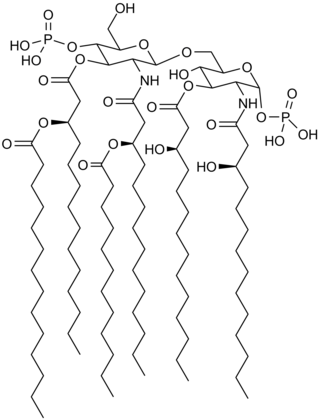
The Chlamydiaceae are a family of gram-negative bacteria that belongs to the phylum Chlamydiota, order Chlamydiales. Chlamydiaceae species express the family-specific lipopolysaccharide epitope αKdo-(2→8)-αKdo-(2→4)-αKdo. Chlamydiaceae ribosomal RNA genes all have at least 90% DNA sequence identity. Chlamydiaceae species have varying inclusion morphology, varying extrachromosomal plasmid content, and varying sulfadiazine resistance.
In enzymology, a 3-deoxyoctulosonase (EC 3.2.1.144) is an enzyme that catalyzes the chemical reaction
In enzymology, a 3-deoxy-8-phosphooctulonate synthase (EC 2.5.1.55) is an enzyme that catalyzes the chemical reaction
In enzymology, a 3-deoxy-manno-octulosonate cytidylyltransferase is an enzyme that catalyzes the chemical reaction

Saccharolipids are chemical compounds containing fatty acids linked directly to a sugar backbone, forming structures that are compatible with membrane bilayers. In the saccharolipids, a monosaccharide substitutes for the glycerol backbone present in glycerolipids and glycerophospholipids. The most familiar saccharolipids are the acylated glucosamine precursors of the lipid A component of the lipopolysaccharides in Gram-negative bacteria. Typical lipid A molecules are disaccharides of glucosamine, which are derivatized with as many as seven fatty-acyl chains. The minimal lipopolysaccharide required for growth in Escherichia coli is Kdo2-Lipid A, a hexa-acylated disaccharide of glucosamine (LipidA) that is glycosylated with two 3-deoxy-D-manno-octulosonic acid (Kdo) residues.
Core oligosaccharide is a short chain of sugar residues within Gram-negative lipopolysaccharide (LPS). Core-OS are highly diverse among bacterial species and even within strains of species

The haloacid dehydrogenase superfamily is a superfamily of enzymes that include phosphatases, phosphonatases, P-type ATPases, beta-phosphoglucomutases, phosphomannomutases, and dehalogenases, and are involved in a variety of cellular processes ranging from amino acid biosynthesis to detoxification.
In molecular biology, the lipopolysaccharide kinase (Kdo/WaaP) family is a family of lipopolysaccharide kinases that includes lipopolysaccharide core heptose(I) kinase rfaP. Lipopolysaccharide core heptose(I) kinase rfaP is required for the addition of phosphate to O-4 of the first heptose residue of the lipopolysaccharide (LPS) inner core region. It has previously been shown that it is necessary for resistance to hydrophobic and polycationic antimicrobials in E. coli and that it is required for virulence in invasive strains of Salmonella enterica. The family also includes 3-deoxy-D-manno-octulosonic acid kinase from Haemophilus influenzae, which phosphorylates Kdo-lipid IV(A), a lipopolysaccharide precursor, and is involved in virulence.
Lipid IVA 4-amino-4-deoxy-L-arabinosyltransferase is an enzyme with systematic name 4-amino-4-deoxy-alpha-L-arabinopyranosyl ditrans, octacis-undecaprenyl phosphate:lipid IVA 4-amino-4-deoxy-L-arabinopyranosyltransferase. This enzyme catalyses the following chemical reaction
Lipid IVA 3-deoxy-D-manno-octulosonic acid transferase is an enzyme with systematic name CMP-3-deoxy-D-manno-oct-2-ulosonate:lipid IVA 3-deoxy-D-manno-oct-2-ulosonate transferase. This enzyme catalyses the following chemical reaction
KDO transferase may refer to:
WaaA (gene) may refer to:
3-deoxy-D-manno-oct-2-ulosonic acid transferase may refer to:
3-deoxy-manno-octulosonic acid transferase may refer to:
(KDO)-lipid IVA 3-deoxy-D-manno-octulosonic acid transferase is an enzyme with systematic name CMP-3-deoxy-D-manno-oct-2-ulosonate:(KDO)-lipid IVA 3-deoxy-D-manno-oct-2-ulosonate transferase. This enzyme catalyses the following chemical reaction
(KDO)3-lipid IVA (2-4) 3-deoxy-D-manno-octulosonic acid transferase is an enzyme with systematic name CMP-3-deoxy-D-manno-oct-2-ulosonate:(KDO)3-lipid IVA 3-deoxy-D-manno-oct-2-ulosonate transferase . This enzyme catalyses the following chemical reaction
3-deoxy-D-manno-octulosonic acid kinase is an enzyme with systematic name ATP:(KDO)-lipid IVA 3-deoxy-alpha-D-manno-oct-2-ulopyranose 4-phosphotransferase. This enzyme catalyses the following chemical reaction
3-Deoxy-2-octulosonidase is an enzyme with systematic name capsular-polysaccharide 3-deoxy-D-manno-2-octulosonohydrolase. This enzyme catalyses the following chemical reaction



